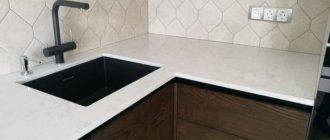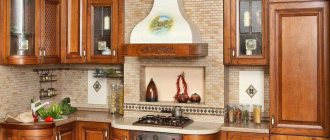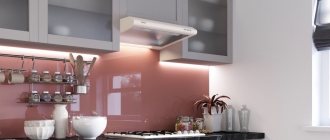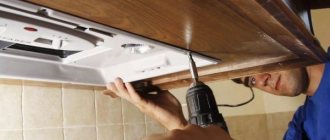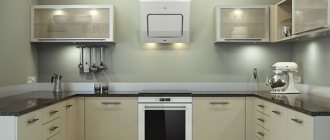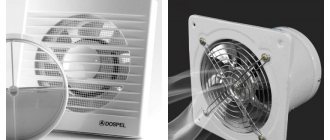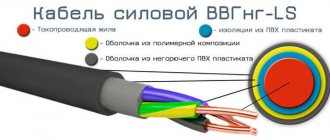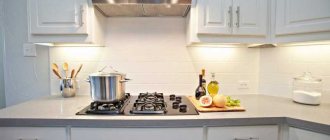Despite the availability of various semi-finished products, pizzas or hamburgers, and full meals delivered to your home, many Russian housewives still prefer to pamper themselves and their family with homemade dishes. And representatives of the stronger sex quite often come to the stove, not trusting store-bought food or wanting to surprise their family with a truly masculine culinary masterpiece. And for some, cooking and the art of cooking is a favorite hobby or profession.
Of course, during the cooking process on the stove, appetizing and not-so-appetizing odors appear. Hot fumes and greasy soot spread throughout the kitchen and throughout the house. To prevent negative consequences, experts give a clear answer: install the hood immediately, at the stage of installing the kitchen unit. But is this really necessary? Is it really impossible to do without a hood? Or can you rely on good natural, forced ventilation in the kitchen? Let us examine this issue in more detail, assessing the advantages and disadvantages of installing this unit.
Hood for domestic needs in the kitchen
This is a device designed to purify the air in the kitchen from gas combustion products, water vapor, small particles of soot and fat. That is, the whole bouquet that pollutes the air and the entire room during the heat treatment of products. It is purchased and installed separately from kitchen units, at the request of the homeowners. What are its features?
- The basis of the design consists of a body made of various materials - glass, plastic, metal. Dimensions, shape and colors depend on the installed design.
- The housing houses a motor that drives the fan. Its power varies, since devices are produced for both tiny and spacious rooms.
- Drawn in by the fan, polluted air passes through a system of carbon filters, or is discharged into the ventilation system and further into the street.
Thanks to these devices, the air in the kitchen is forcibly purified in a short time. If you turn them on at the very beginning of the cooking process, the vapors and soot simply do not have a chance to spread throughout the entire room.
Are there any negative properties of the hood?
Despite the benefits of a kitchen appliance, there is a point of view that it can cause harm. Disputes on this matter do not subside. Below are several popular misconceptions and their refutation.
| Myth | In fact |
| Grease traps with settled fat particles are a favorable environment for the growth of bacteria. | Timely cleaning and replacement of filters makes the device completely safe. In addition, grease deposited on furniture and tiles poses the same threat. |
| The noise of the hood gets on your nerves and drowns out other sounds. | There are silent hoods on the market (for example, PYRAMIDA BR 60/A WHITE). Besides, the kitchen is already full of sounds. Against the background of the noise of tap water, boiling food and the operation of the same refrigerator, the noise of the hood is almost unnoticeable. |
| A ventilation system is sufficient to clean the air. | Indeed, in an ultra-compact kitchen, an open window is often enough. But how much a winter draft justifies the cleanliness and freshness of the air is up to each user to decide. |
Read more on the topic: WHY IS THE HOOD SO NOISE? 3 MOST COMMON SITUATIONS
Diverter kitchen hoods
This class of exhaust devices is connected to the building’s ventilation system, or to pipelines leading through the wall to the street. Taking the air saturated with vapors from inside the room, they remove it outside through a filter on which soot remains. It is believed that such devices purify the air better and faster. But they also have disadvantages:
- not all houses have a ventilation system and it is not always possible to connect to it;
- pipes, even those chosen in color and shape, spoil the appearance of the kitchen and take up precious meters of space;
- installation is more difficult than for compact pendant systems.
To properly install and connect a tap-off model, experience or a hired specialist is required.
A little theory
Before we begin discussing the advantages and disadvantages of these household appliances, let us briefly examine their classification.
According to the principle of operation, hoods are divided into:
- recirculation - they draw in polluted air, clean it from burning, grease and soot through built-in filters and return it back to the room. They have average or low power, require regular replacement of filtration units, are noisy, do not cope well with unpleasant odors, but take up little space, are inexpensive and easy to install;
- flow-through ones - they quickly remove dirty air to the street through the ventilation system of the house along with an unwanted aroma, have impressive dimensions, require the involvement of specialists for proper installation, are expensive, but they cope with their tasks perfectly and almost do not bother the owners with extraneous sounds.
According to their design and installation method, they are:
- hanging - attached to the bottom of any cabinet;
- built-in - they act as part of a furniture set and visually do not give themselves away;
- dome - rise above the slab and go into the ceiling or wall;
- island - installed in the center of the kitchen and cover a large area.
There are hoods that combine flow and recirculation principles of operation and allow you to select the desired mode according to the circumstances.
Recirculating kitchen hoods
Circulation systems do not have air ducts. The dirty air supplied inside passes through a filter system, is cleaned, and then discharged back into the kitchen. That is, the same air circulates in the room, without access to fresh air from outside. Therefore, the kitchen must be ventilated from time to time, otherwise the concentration of carbon dioxide may exceed reasonable limits. In addition, such devices often cannot cope with rich odors and combustion products of household gas from a gas stove.
They also have advantages:
- compact dimensions;
- the ability to install under cabinets, in countertops, on walls;
- ease of installation.
This type of hood can be installed independently if you carefully follow the attached instructions.
Which hood is better for an electric stove?
The main parameter for calculating the size of an exhaust system is the scale of the slab over which it is mounted.
If the stove has 4 burners and overall dimensions, it is better to take a hood from 60 cm - for example, Electrolux LFP316S. For a kitchen with compact stoves of 50 centimeters, compact hood models are chosen (an excellent option is the Beko FSM57300GX stove with oven).
How to choose a size
The calculation rule states: the working surface of the hood should be 10-30% larger than the width of the electric stove. Example: for a 90 cm hob, a 120 cm wide hood is suitable.
Note: Do not worry about the aesthetics of a large hood - modern models are compact due to their thoughtful design. And so that it is not visible at all, they choose a built-in structure.
How to calculate the mounting height
It is recommended to hang the hood at a height of 65 cm. At this level from the stove it is most comfortable to cook food. If you install the device at a greater distance from the countertop, it will work “idle”; if at a smaller distance, it will be inconvenient during the cooking process. In addition, the heat from a nearby stove will damage the hood components.
Interesting : It is worth considering the distance of the outlet from the device - this way you will not need to extend the wire of the equipment you just purchased.
To sum it up, we can say: it’s rare that a kitchen can do without a hood. The equipment will free the air from carcinogens and burning impurities and destroy odors that can be dangerous to the health of some people. A properly installed hood will extend the life of household appliances, furniture and wall coverings. It will catch droplets of grease before the dirt covers the kitchen area. To choose the best hood for a tandem with an electric stove, you need to take into account the type of device, the area of the kitchen itself and the size of the hob.
Dome kitchen hoods
The hoods of this model have an original canopy in the form of a dome, in which the engine, filters and all the necessary mechanics are located. Due to their interesting appearance, the devices are called “fireplace”. They are often used as an expressive decorative element. The only negative is the large dimensions.
What ventilation would be the best option?
For people who are building a large country house or making renovations in an elite apartment, we can recommend an expensive, high-quality and efficient ventilation system with heat recovery. Owners of expensive real estate install a powerful hood, and the outlet for the exhaust air should be made in the wall. Instead of a gas stove, it is better to use an electric household appliance due to lower emissions of carcinogens.
For developers who are limited in financial resources, the best option would be to use natural ventilation, which is supplied to the kitchen, bath and toilet, as well as auxiliary rooms. If a private house will use a hood installed above a kitchen stove, then a channel for removing waste air masses is made not in a vertical direction to the roof, but in the wall. A check valve is installed on the fan; it prevents cold air from entering the room from outside.
The best option for apartment owners is the natural ventilation already existing in the house. In addition, a hood is installed above the stove in the kitchen with air exhaust through a hole in the wall. If this option does not work, the fan is mounted in the riser of the existing duct, but the check valve is removed.
Hood or ventilation in the kitchen?
The debate over the need for hoods in the kitchen continues. People defend diametrically opposed opinions. Some people claim that it is impossible to live and create in the kitchen without it. But for some, this unit is a waste of money, since high-quality ventilation provides the necessary air exchange, and in extreme cases there are vents and transoms.
To understand whether the kitchen really cannot be done without an exhaust hood, it’s worth weighing the pros and cons. And, of course, the issue should be resolved taking into account specific facts. After all, the conditions in different apartments and houses are very different, and no two families have completely the same habits and way of life.
Arguments against kitchen hoods
According to many users, these devices are imposed by companies that manufacture household appliances and kitchen furniture. Opponents of installing hoods cite quite compelling reasons according to which the purchase of the investment does not justify and even brings certain inconveniences:
- during operation, the unit makes noise from the motor and fans, adding extraneous sounds to the otherwise restless atmosphere of the kitchen;
- if there is good, well-thought-out ventilation, there is not much difference between the presence and absence of an additional exhaust device. Today, many houses have a forced ventilation system, installing special mechanisms and motors with fans. If such communications are available, it makes no sense to spend money on a hood. But owners of apartments or private houses with poor or no ventilation should think about it. Its quality can be judged by the air and the presence of mold: if the atmosphere with the windows closed is fresh, with normal humidity, then everything is in order;
- many owners prefer to work in the kitchen with an open window or vent, which automatically makes the purchase of additional household appliances pointless;
- during operation, the device consumes electricity, which affects electricity bills;
- the owners practically do not cook in the kitchen, or prepare dietary dishes without frying the food;
- Fat and soot settle on the filter, creating a favorable environment for the development of microorganisms. Therefore, the hood needs proper care and timely cleaning and replacement of filter elements.
And, one of the main arguments against it is the lack of space in the kitchen. In small kitchens there is often no free space left in which to accommodate a dome or inclined hood with an air duct.
Arguments against"
- “All my life we managed without her and nothing happened.” Representatives of the older generation sincerely do not understand why install additional devices for air purification when it is enough to turn on a wall hood or arrange through ventilation through a window and door.
- "No extra money." Any equipment requires costs for purchase, installation and maintenance, and if the budget is sharply limited, they usually save on minor things, which include a range hood.
- “So little space.” Of course, a bulky island or dome model will not fit into the interior of a Khrushchev kitchenette, but a hanging or built-in option is not difficult to choose.
- "It's too loud." Yes, outdated appliances with weak motors are far from the standards of acoustic comfort, but among the new products you can find an inexpensive and quiet range hood.
- “It spoils the interior.” Equipment purchased for a ready-made kitchen can really deviate from the overall design concept. To avoid this, the purchase must be planned in advance, at the stage of repair and arrangement.
- “Filters are a breeding ground for infection.” This will happen if you do not replace them in a timely manner and do not clean the inside of the device.
- “I have an electric/induction stove.” Under this condition, the need for a kitchen hood is lower than when using gas, but cleaning the air from unnecessary moisture, odors and food particles will not hurt.
- “Household ventilation copes with ventilation.” A reasonable argument, but not everyone is so lucky.
- “I hardly cook at home.” Many busy people prefer to order food for delivery, purchase reheatable convenience foods, or eat out.
- "It's a fashion statement." Some people think that home appliance manufacturers exaggerate the benefits of hoods in order to promote their products on the market and capitalize on indoctrinated customers.
How hoods differ according to operating modes
Sometimes the ventilation mode is one of the main criteria that the user takes into account when choosing. Therefore, before purchasing, it is necessary to decide what types of kitchen ventilation structures are usually divided into.
- Circulating . These devices operate on the principle of an air conditioner, only instead of a cooler, cleaning carbon filters are installed inside. The air passes through them and returns to the room already clean and fresh. These devices are easy to install (just hang them in the right place and plug them into an outlet), but they are ineffective in cleaning.
- Flow-through . This is an improved analogue of the previous device. It requires a mandatory air duct to the street, as it absorbs all the polluted air and sends it outside the house. The devices are recognized as more productive than the previous type and, accordingly, durable.
When choosing a device based on its operating principle, you must clearly understand what kind of performance you need. If you purchase devices with a carbon filter, they are subject to regular maintenance, as they quickly lose their ability to circulate contaminated air.
Remember not only about mounting the device, but also about the electrical supply to it.
Flow type kitchen hoods have a complex installation system, but this does not mean that you need to involve a professional. If you carefully study the instructions, you will definitely be able to do it on your own.
Ventilation system design
A project for private housing construction or an apartment building without organizing a natural ventilation system will not be accepted by the relevant organizations.
To remove accumulated moisture, heat flow, and unpleasant odors, ventilation exhaust ducts are planned.
The flow of fresh air is carried out naturally, or through organized channels near the window.
Let's understand additional functions
- Almost all hoods are equipped with lamps. This simple addition often comes in handy when cooking, so it makes sense to test the lighting in the store to see how easy it is to turn on and replace the lamp. Ideally, the light bulbs in the hood should be LED - they are safe, do not fade for a long time, do not heat up and can be easily disposed of.
- Depending on the “sophistication”, you can see models with 1-2 air intake speeds and even 10. In our opinion, there is little point in overpaying for an abundance of speeds; 3-4 modes will be quite enough for most non-professional cooks.
- Also, modern hoods are almost always equipped with a timer or a residual stroke button, which makes it possible to synchronize its operation with the stove.
- When buying a hood, you should make sure that it has protective shutdown sensors and a sensor that reminds you that it is time to replace/clean the grease filter.
- Some manufacturers (for example, Siemens) even build televisions into hoods.
